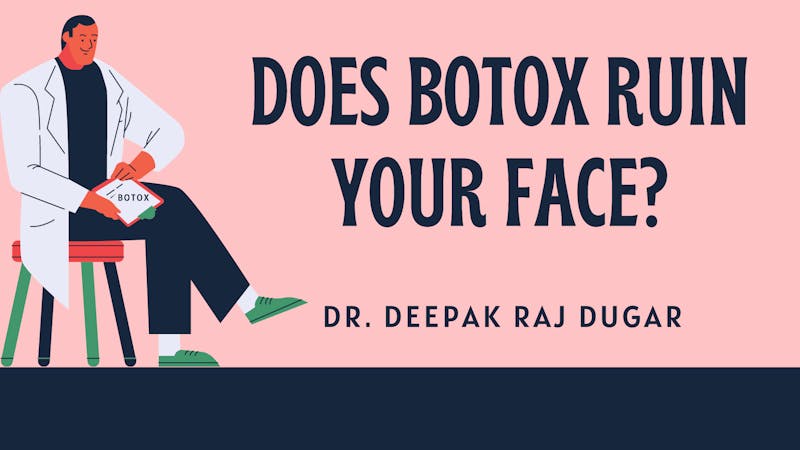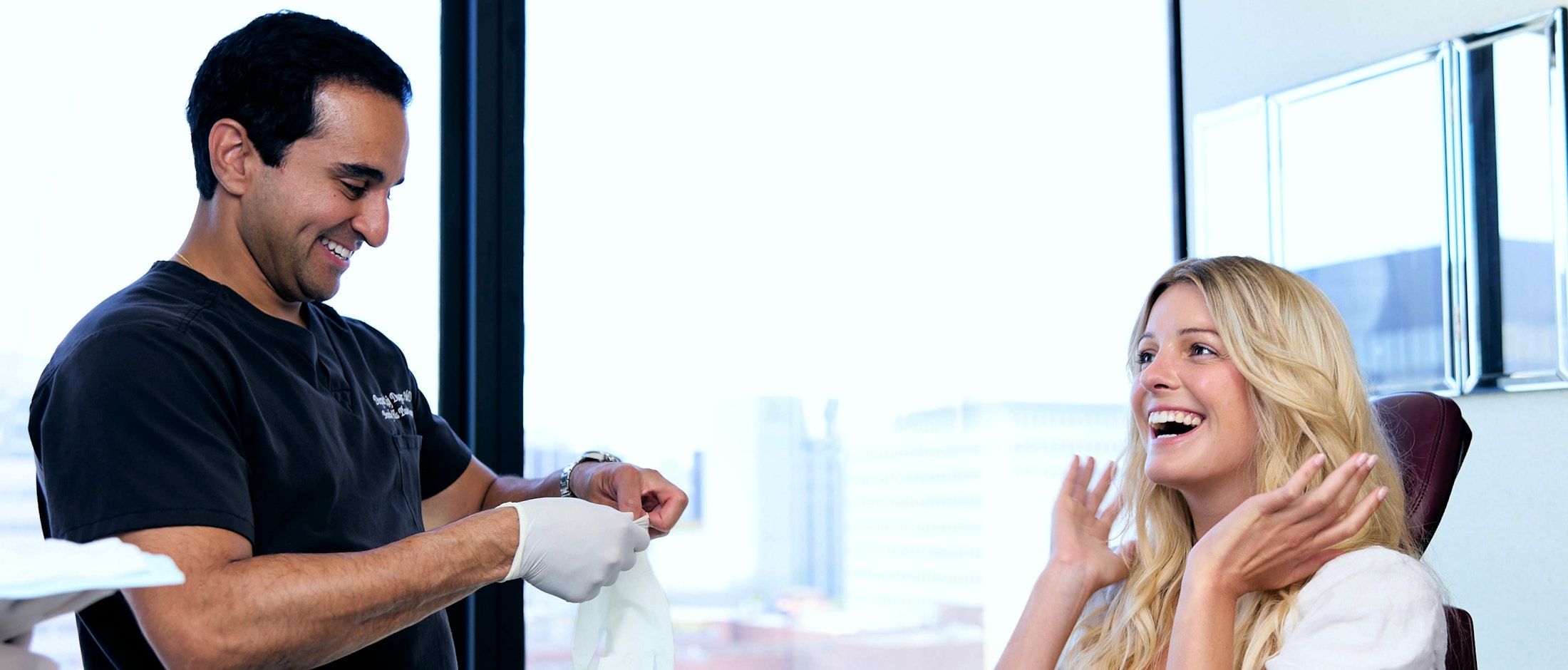Introduction:
Botox is a cosmetic treatment for reducing the appearance of wrinkles and fine lines. It is also used to treat recurring medical issues like bruxism, migraines, excessive sweating, and muscle spasms. It is a popular treatment due to its effectiveness, ease of use, accessibility, and relatively low risk of complications when administered by a trained professional. Botox is a brand name for FDA-approved cosmetic injectables alongside Dysport, Jeuveau, and Xeomin.
Definition of Botox
Botox, short for botulinum toxin, is a neurotoxic protein – that said, does Botox ruin your face? Despite being made from a toxin, Botox injections are considered a safe and effective way to treat wrinkles when administered by a qualified professional. When injected in small amounts into certain areas of the face or body, Botox reduces the appearance of wrinkles and fine lines by temporarily relaxing the muscles and preventing them from contracting.
It works by blocking the release of acetylcholine, the chemical responsible for transmitting signals from nerves to muscles. It is a popular non-invasive cosmetic treatment because it does not involve surgery or any incisions into the skin.
How Botox Works
Botox works by paralyzing or relaxing dynamic muscles, giving the skin a smoother and more youthful appearance. It does this by blocking the signals from the nerves to the muscles, preventing them from contracting. But does Botox change your face? No, it does not – its effects typically last for three to six months, after which the muscles will eventually regain their normal function.
During treatment, the practitioner uses a fine needle to inject a very small dose into the target areas. They will usually numb the injection site with a topical anesthetic cream to reduce discomfort.
Does Botox Ruin Your Face?
Does Botox ruin your face? Studies have shown that Botox (most commonly known as the brand name Botox), when used in low but effective doses, does not ruin your face, but rather is a temporary paralyzation of the microscopic muscle nerve endings.
If you overdo botox, you run the risk of freezing your face, having no movement when you show expression, and not looking like your natural self. This risk of looking unnatural and expressionless is only possible if you go to a facial injector who injects too much Botox at once, and you repeatedly go back often and get large amounts of the Botox injected month after month.
This frozen effect can happen to facial expressions because the botulinum toxin (Botox) is a temporary paralyzation of the nerve endings in small muscle fibers. The injection of the brand name of this toxin (Botox, Dysport, Jeuveau, or Xeomin) blocks the muscles from releasing the chemicals they use to contract, thus causing muscle weakness in the areas that contract often and leave wrinkles on the face. This relaxes the tiny muscle fibers where the skin wrinkles, creating a smoothing effect on the face. Over-injecting, thus creating more muscles in the face to relax, can make the large areas of the face lose their contraction and lose their expression.
Receiving precise and detailed care from a skilled facial injector is the most important part of anyone’s Botox journey. Facial botox and filler injector to the stars is Dr. Deepak Raj Dugar, who gives all his patients careful, gentle injections out of his office overlooking the Hollywood Hills in Beverly Hills, California. Here, just one block from Rodeo Drive, Dr. Deepak Dugar listens to each of his patients’ needs and goals and encourages them to come back every 3-5 months for maintenance on his small, light injections of Botox. This maintenance encourages wrinkle-reducing for a youthful appearance, while avoiding all risk of over-injection and heavy doses of Botox in the face that could possibly ruin the appearance of your face.
Myths and misconceptions about Botox
One of the most common misconceptions about Botox is that it will make your face look frozen or perpetually surprised. When administered correctly by an experienced injector, Botox can relax facial muscles without affecting your natural facial expressions.
Another myth is that Botox is a permanent solution. Does Botox change your face? Only temporarily – the effects will gradually wear off, and clients must get repeat treatments to maintain their results.
Lastly, there is a misconception that Botox is only meant for older people. Although Botox is known as an anti-aging treatment, it can also be used to potentially prevent the formation of new wrinkles in younger clients.
Factors that affect the outcome of Botox treatment
Does Botox ruin your face? The outcome of Botox treatment depends on several factors. These include the client’s age, facial structure, and overall health, as well as the dose and target areas of the Botox injection. Different muscle groups can have varying sensitivities to the toxin, and the dosage should be appropriate for the area being treated. Younger clients may also require a smaller amount of Botox because their skin is more elastic and has better collagen support. Moreover, the skill of the injector also makes a difference. A practitioner with significant experience in administering Botox can ensure safe and optimal results.
How to Get Safe and Effective Botox Treatment
Botox is a relatively safe, quick, and easy procedure that typically produces noticeable results within a few days. Before getting Botox treatment, inform the injector of your medical history and of any skin treatments (such as laser) and medications you’re taking, such as over-the-counter drugs and supplements. Work with a qualified medical professional who administers injections in a medical office or clinic. Make sure that the Botox brand they intend to use is FDA-approved.
It is also important to follow the injector’s post-treatment instructions carefully. These may include avoiding excessive sun exposure, strenuous activities, and rubbing or pulling the injected area following treatment. Monitor the injection site for side effects and attend follow-up appointments as recommended by the injector to maintain the desired results.
Understanding the treatment process
Botox is administered through a series of injections into the targeted muscles. The number of injections depends on the severity of the wrinkles or lines and the area being treated. In most cases, the procedure only takes several minutes to complete.
Before administering injections, the practitioner will apply a topical anesthetic or apply an ice pack to numb the area and reduce discomfort. The effects will become apparent within a few days to a week, though it often takes up to two weeks for the full effects to become noticeable. The procedure is relatively painless, and clients can return to normal activities almost immediately after treatment.
Preparing for Botox treatment
Botox is considered a less invasive option for reducing the appearance of fine lines and wrinkles compared to invasive cosmetic procedures like facelifts. However, clients are usually advised to refrain from taking blood-thinners and alcohol right before and after treatment to keep swelling and bruising to a minimum.
If you have had laser treatment to the target area, it is generally recommended to wait at least one to two weeks before getting Botox injections. This will ensure that the treated area has fully healed and that laser treatment has not caused any side effects that could potentially be affected by Botox injections.
It also helps to make sure your skin is clean and free of makeup or other products before getting Botox treatment. This will make it easier for the injector to see your face's natural texture or contours.
Frequently Asked Questions
What is Botox good for
Botox smoothes out wrinkles and lines for a refreshed and more youthful appearance. It is known for treating dynamic wrinkles that are caused by repetitive facial movements or expressions like frowning, squinting, or furrowing your brows. These wrinkles often appear on the forehead, between the eyebrows, and around the mouth and eyes. Botox can also be used to treat other areas of the face, such as the jawline, chin, and neck
But what is Botox good for besides cosmetic enhancements? Botox is also widely used to treat an overactive bladder, neck spasms, lazy eye, and temporomandibular joint disorder (TMJ).
Is Botox bad for you long term?
There is currently no evidence to suggest that Botox is harmful when administered by a qualified medical professional. While there are potential risks and complications associated with Botox, such as bruising and swelling at the injection site, these side effects are often mild and subside within a few days or weeks.
But is Botox bad for you long term? Although there are concerns about long-term effects like muscle atrophy or loss of facial expression with repeated Botox injections, there is no conclusive evidence yet to verify these outcomes. Does Botox ruin your face in the long run? Botox injections are known to do the opposite – a skilled practitioner can improve the overall appearance of your face.
What happens when you stop Botox?
If you stop getting injections, the cosmetic benefits will wear off over time. What happens when you stop getting Botox is that the muscles temporarily paralyzed by the injectables will slowly regain their normal function, and wrinkles and fine lines may reappear. Exactly when this happens varies depending on the dose and specific areas treated.
Stopping Botox treatment will not necessarily cause any permanent harm to the skin or muscles. The treated areas will simply return to their state before Botox was injected. If you are thinking of stopping Botox treatment, you can discuss alternatives with your practitioner.
What happens if you get Botox too often?
Scheduling or spacing out Botox treatments will allow the effects of previous injections to wear off. What happens when you get Botox too often is that you may experience an increased risk of side effects like bruising or swelling. It can also lead to a buildup of antibodies, which can potentially reduce the effectiveness of Botox over time. This phenomenon is also known as Botox resistance. To avoid these side effects, it is important to follow the correct treatment schedule. A skilled injector will also adjust the dosage to prevent overuse.
Where can you get Botox in your face?
Botox can treat areas of the face where dynamic wrinkles and fine lines are present. These include the forehead, glabella (the area between the eyes), chin, and jawline. Botox can be used to treat crow’s feet around the eyes, laugh lines (also known as marionette lines) around the mouth area, and bunny lines on the sides and below the ridge of the nose. It can also lift heavy upper eyelids and drooping eyebrows when injected strategically into the muscles that cause the brows to point downward. An experienced practitioner will help you determine where you can get Botox in your face for the best results.
Conclusion:
Dr. Dugar’s philosophy is that some things, like cosmetic procedures, should go unnoticed. Meaning, that he would much prefer you look more natural, and like yourself, rather than over-done and everyone walking on the street would be able to notice you got a cosmetic procedure done.
Known as “The Plastic Surgeon to the Stars”, Los Angeles-based practitioner Dr. Dugar brings this philosophy to the operating room, where he performs Scarless closed rhinoplasty, leaving no external cuts and scars and creating a better, more refined version of patients’ own noses. Dr. Deepak Dugar also takes his light-handed approach to the clinic room where he injects super small, or baby Botox, as he likes to call it. On his patients, Deepak Dugar would rather inject too little, so patients can come back for a small touch-up, rather than too much, where you run into more risks of looking fake.
If you are thinking whether Botox injections are right for you now at your age, Dr. Dugar would love to speak more in detail in a consultation, where he will be honest and help guide you on all the options you have, and how to achieve your goals at the lowest risk possible. Call/text or email us below to learn more, or you can book your very own Scarless Med Spa appointment for possible Botox or fillers from Dr. Dugar on our website below.



